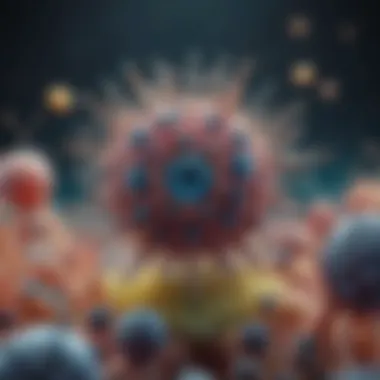Understanding Culture Medium for Viruses and Their Impact


Intro
The study of viruses presents distinctive challenges, particularly in understanding and isolating these minuscule entities. One of the critical components in virology research is the culture medium used to propagate and study viruses. Culture mediums create an environment where viruses can thrive, allowing researchers to observe their behavior and interactions. This article will outline the fundamental aspects of culture mediums, their formulations, and their significance in virology.
Background and Context
Overview of the research topic
Culture mediums serve as environments for microorganisms, including viruses. Unlike bacterial cultures, viruses cannot multiply outside a host. Thus, optimizing culture mediums tailored for specific viruses is key to successful experimentation. The composition of a culture medium typically includes nutrients, buffers, and supplements that facilitate the growth of host cells and ultimately allow for viral isolation and characterization.
Historical significance
Historically, the origins of culture mediums can be traced back to the early 20th century when scientists began manipulating nutrient solutions in laboratory settings. The development of Luria-Bertani broth and Eagle's Minimum Essential Medium marked significant milestones. These early formulations laid the foundation for modern virology. Optimizing the culture medium for specific viruses has advanced our understanding of viral pathogenesis, immune response, and virotherapy.
Key Findings and Discussion
Major results of the study
Research indicates that the choice of culture medium profoundly impacts the outcomes of virology studies. The results show varying levels of viral replication based on the medium composition. Different viruses often require unique environments for effective growth. Therefore, selecting the right culture medium is essential for accurate results.
- Virus propagation: Certain mediums support virus replication more effectively than others. For instance, Madin-Darby Canine Kidney (MDCK) cells are commonly used for influenza virus culturing.
- Experimental outcomes: The results are directly linked to how well the virus can be isolated. If the culture medium does not provide sufficient nutrients or optimal pH levels, the replication of the virus diminishes.
Detailed analysis of findings
A detailed examination of various culture mediums reveals that they are not all created equal. Factors influencing medium effectiveness include:
- Nutritional composition: The presence of specific amino acids and vitamins is crucial for supporting viral growth.
- pH levels: These should be closely monitored, as extreme deviations can impact viral stability.
- Temperature: Each virus may require specific incubating temperatures.
"Selecting an appropriate culture medium is not merely a technical choice; it is foundational to the success of virology experimentation."
Understanding the complexities involved in medium selection is essential for a fruitful research endeavor. The challenges identified in culture medium formulations highlight the need for continued innovation in this area. This will help scientists combat emerging viral threats and advance virology as a critical scientific field.
In summary, the optimization of culture mediums is a vital aspect of virology research, influencing both the efficacy of viral propagation and the reliability of experimental results. Each choice made in this regard can ripple through the entire research process, underscoring the importance of comprehensive understanding in this specialized area.
Prolusion to Viral Culture Medium
The study of viruses heavily relies on the use of culture mediums. These mediums provide a controlled environment that fosters viral growth and replication. Understanding the principles behind viral culture medium is essential for researchers out there who engage in virology. The choice of culture medium affects not only the virus's ability to replicate but also the results obtained from various experiments.
Culture mediums serve as a partial mimicry of the natural environment in which viruses thrive. It ensures that all necessary nutrients are available for successful cultivation. An optimal medium can significantly enhance the yield of viral particles, facilitating studies related to transmission, pathogenicity, and treatment strategies. The consideration of various factors, such as nutrient composition and physical conditions, is crucial in this context. Every detail matters—how components interact can influence everything from viral behavior to research outcomes.
In this article, we will explore the significance of culture mediums in virology. We aim to cover various types and formulations, their specific roles, and how they contribute to the advancement of virology as a scientific discipline. Additionally, we will highlight the challenges faced in developing effective culture mediums and discuss directions for future research in this essential field.
"The medium in which a virus is cultured can define not only growth but could yield insights into viral interactions with host cells."
This exploration will be particularly relevant for students, researchers, educators, and professionals seeking a comprehensive understanding of virus culture methodologies.
Types of Culture Medium
Understanding the different types of culture medium is crucial for their effective application in virology research. These mediums serve as a controlled environment for viruses, providing essential nutrients and conditions for sustained growth and isolation. Choices made regarding the type of culture medium affect the efficiency of viral propagation and the validity of experimental outcomes. The optimization of culture conditions hinges on the specific requirements of the viral agent and its host cells.
Cell Culture Media
Cell culture media are indispensable tools for studying viruses. They provide the necessary nutrients, energy source, and vitamins for growing cell cultures, which act as hosts for viral replication. Commonly used cell culture media include Dulbecco's Modified Eagle Medium (DMEM), Minimum Essential Medium (MEM), and RPMI-1640. Each of these media formulations is fine-tuned for different cell types, with attention to pH and osmolarity being vital factors.
The effectiveness of these media can directly impact research outcomes. For instance, the choice between DMEM and RPMI might affect the growth rate of specific cell lines. Research demonstrates that nutrient depletion can lead to metabolic stress, which may complicate viral assays. Therefore, selecting the right cell culture media can enhance the clarity of research findings and reduce experimental variability.


Liquid vs. Solid Media
The choice between liquid and solid media also warrants careful consideration. Liquid media encourage high cell densities and are often used for growing suspension cultures. They facilitate easier sampling and handling, leading to streamlined processes in large-scale vaccine production. Conversely, solid media, generally supplemented with agar, support the growth of adherent cells, providing a more stable environment for certain experiments.
Each type has its pros and cons. For example, liquid cultures allow for rapid growth but may complicate the isolation of viruses. Solid media can assist with observation of viral plaques, which are important for quantifying viral load. Studies show that the physical state of the medium can influence virus-host interactions, thereby shaping research strategy.
Selective Media for Viral Isolation
Selective media for viral isolation play a pivotal role in the purification of specific viruses from mixed cultures. These media are formulated with particular inhibitors or supplements aimed at supporting the growth of target viruses while suppressing others. For instance, the use of antibiotics can help to reduce bacterial contamination in viral cultures.
The application of these selective media enables researchers to focus on specific viruses, enhancing the chances of successful isolation. This is particularly relevant in studies targeting emerging viruses, where traditional culture methods may fall short.
Selective media not only streamline virus isolation but also enrich the study of viral behaviors and interactions within target cell lines.
In summary, grasping the nuances of different culture mediums—such as cell culture media, the choice between liquid and solid states, and the use of selective media—can significantly advance the field of virology. The right medium enhances not only virus propagation but also the reliability of research outcomes.
Key Components of Culture Medium
The composition of culture medium is critical for successful virus isolation and study. These components enable optimal conditions for viral replication and growth. Understanding the key elements of culture media assists researchers in tailoring the environment to the specific requirements of the viruses they are investigating. This section breaks down the essential components of culture medium into three main categories: nutrients and supplements, buffers and pH regulation, and antibiotics and antimycotics.
Nutrients and Supplements
Nutrients are fundamental to the support and propagation of viruses in culture media. They must provide the essential building blocks that sustain cellular activities. Common nutrient sources include amino acids, carbohydrates, vitamins, and minerals. Each of these components plays a unique role:
- Amino Acids: These are vital for protein synthesis, which is crucial for viral assembly and function.
- Carbohydrates: Often provided in the form of glucose, these are necessary for energy generation. Viruses rely on host cells for energy, but providing a readily available source aids in initial cellular metabolism.
- Vitamins and Minerals: These are important for enzymatic reactions and cellular processes.
Adding supplements, such as serum, enhances nutrient availability and offers additional factors that may be required for specific viruses. For instance, fetal bovine serum is commonly used due to its richness in nutrients and growth factors. However, reliance on serum should be monitored due to the risk of variability in composition.
Buffers and pH Regulation
Maintaining a stable pH is vital for the viability of both cultured cells and viruses. Buffers are chemical substances that resist changes in pH when acids or bases are added. The most commonly used buffer in viral culture media is sodium bicarbonate, often in combination with CO2 to maintain physiological pH levels. This balanced environment ensures optimal enzyme activity and metabolic functions vital for preserving viral integrity during the culture process.
The pH of the culture medium can significantly influence viral yield and behavior. A pH that is too high or too low can inhibit growth or lead to the degradation of viral particles. Regular monitoring and adjustments can help maintain the desired pH range, facilitating successful viral propagation.
Antibiotics and Antimycotics
Contamination in cell cultures is a significant challenge in virology research. Bacterial and fungal contamination can compromise experimental results and lead to erroneous conclusions. For this reason, antibiotics and antimycotics are often included in culture media to reduce microbial growth.
Common antibiotics used include penicillin and streptomycin, which target specific bacteria without affecting the viral particles. Likewise, antifungal agents like amphotericin B help prevent fungal growth.
It is important to use these agents judiciously, as over-reliance can lead to resistance and complicate future studies. Researchers must consider the antibiotic sensitivity of the cells they are using and ensure that the presence of these agents does not inadvertently affect viral behavior.
While the addition of antibiotics and antimycotics is beneficial, regular monitoring of contamination is still essential to maintain the integrity of the culture.
Optimization of Culture Conditions
The optimization of culture conditions plays a crucial role in virology research. Optimized conditions can significantly impact the overall health of viral cultures, the efficiency of propagation, and the reliability of experimental results. In a laboratory setting, viruses require specific parameters to thrive. These conditions directly influence viral replication and, subsequently, the success of any downstream applications. For researchers and practitioners in the field, understanding how these factors interact is essential for effective virus study and manipulation.
Temperature and Oxygen Levels
Temperature is one of the most critical environmental factors in culture media. Each viral strain has an optimum temperature for replication. For instance, many human viruses replicate best at temperatures close to physiological levels, typically around 37°C. Other viruses, such as those from the avian family, may thrive at lower or higher temperatures.
Oxygen levels are also vital. Some viruses require aerobic conditions to replicate efficiently, while others may prefer anaerobic environments. Failure to provide the correct temperature and oxygen balance can lead to inhibited growth, or even inactivation of the virus, compromising experimental outcomes. Consequently, monitoring and controlling these factors in a culture setting can lead to more successful viral studies.
CO2 Concentration


The concentration of carbon dioxide (CO2) in culture media is another factor that researchers must consider. Many cell types, particularly those derived from mammals, require a specific level of CO2 to maintain their pH balance and to create a suitable environment for viral replication. Typically, a CO2 concentration of 5% is common in many protocols. This level supports optimal cell metabolism and enables better virus growth.
Adjusting CO2 involves using incubators equipped with precise controls. Inadequate CO2 levels can adversely affect cellular activities and lead to inaccurate experimental results. Therefore, keeping a close eye on CO2 concentration is paramount in the successful culture of viruses.
Humidity and Atmospheric Pressure
Humidity plays an important role, especially in environments where cells and viruses are cultured. If humidity is too low, it can cause evaporation of culture media, which can lead to an increase in osmotic pressure and potential damage to cells. Conversely, overly humid conditions can promote contamination. Proper humidity levels help maintain the stability of culture conditions and support cellular integrity.
Atmospheric pressure is another variable that should not be ignored. Some cell lines respond to varying atmospheric pressures by altering their growth rates. Ensuring that pressure is kept at standard laboratory levels can help maintain a consistent environment for both cells and viruses.
Proper optimization of culture conditions is essential for accurate and reproducible results in virology research.
In summary, the optimization of culture conditions is an intricate balance between temperature, CO2 concentration, humidity, and atmospheric pressure. Each parameter impacts the vitality of viral cultures and the reliability of experiments. Researchers must understand and control these factors to obtain the best possible outcomes in their virology work.
Applications in Virology Research
The applications of culture medium in virology research are manifold and critical to the advancement of this scientific field. Culture mediums provide the essential environments where viruses can replicate and be studied extensively. Understanding these applications not only aids in viral propagation but also enhances developments in vaccines and diagnostic methods. Each application has unique requirements and benefits, and a deep knowledge of these aspects is essential for researchers and practitioners in virology.
Viral Propagation Techniques
Viral propagation techniques rely significantly on the quality and formulation of culture mediums used. These methods are essential for isolating and growing viruses in a laboratory setting. The correct culture medium enables researchers to maintain viable viral stocks, which can be utilized for various studies.
Important aspects of viral propagation techniques include:
- Selection of Cell Lines: Different viruses require specific cell lines for optimal growth. For instance, influenza viruses thrive in Madin-Darby Canine Kidney (MDCK) cells, while polioviruses can be cultured in HeLa cells.
- Passaging: This process involves transferring viral inoculum into fresh culture medium to ensure continued viral replication and increase viral yield. Calculating the right dilutions and timing is crucial during this step.
- Monitoring: Researchers must regularly observe the viral culture for cytopathic effects, which indicate viral replication and health of the cell cultures. This monitoring is essential for determining the time to harvest the viral particles.
Vaccine Development
Vaccine development is another area where culture mediums play a pivotal role. For vaccines to be effective, the virus used in the vaccine must be cultivated under optimal conditions to maintain its viability and immunogenicity.
Key points in vaccine development include:
- Live Attenuated Vaccines: These require viruses to be cultivated in specific conditions that permit the modification of virulence. This process often demands fine-tuning of the culture media’s nutrients and environment.
- Inactivated Vaccines: The viruses must be propagated first, and then inactivated. Culture mediums must ensure the integrity of the viral particles prior to inactivation.
- Quality Control: Safety and efficacy testing of vaccines rely heavily on the data derived from viral cultures. This requires rigor in maintaining consistent conditions throughout the cultivation process.
Diagnostic Test Development
The role of culture mediums in diagnostic test development is equally important. They are vital for isolating pathogens from clinical samples, allowing for precise diagnosis of viral infections.
Considerations here include:
- Isolation Techniques: Effective diagnostic tests hinge on the successful isolation of the virus. Specific culture mediums are designed to promote growth of target viruses while inhibiting bacterial contamination.
- Test Validity: The results obtained from cultured viruses aid in confirming the presence of an infection. Therefore, media choice can significantly impact the reliability of diagnostic tests.
- Standardization of Procedures: Consistency in preparation and use of culture mediums ensures that diagnostic tests can be replicated, which is essential for clinical accuracy.
"Proper formulation and application of culture mediums lay the groundwork for advancements in virology that directly impact public health and safety."
Developing a comprehensive understanding of the applications of culture media in virology research enhances the overall framework for studying and combating viral diseases. As the field advances, optimizing these applications remains at the forefront of virology and biomedical research.
Challenges in Culturing Viruses
Culturing viruses presents a variety of challenges that can affect research outcomes and applications in virology. Understanding these challenges is crucial for optimizing culture techniques and improving the effectiveness of studies related to virus behavior, vaccine development, and therapeutic interventions. Key elements like contamination, cell line limitations, and biohazard safety must be addressed to facilitate successful viral culture. Each aspect has significant implications that impact virology research and its advancement.
Contamination Issues
Contamination is a persistent problem in viral culture, leading to skewed research results and unreliable data. Sources include bacterial, fungal, or mycoplasma contaminants that can outcompete the viruses being studied. Contaminated cultures not only render experiments ineffective but also introduce variables that complicate data interpretation.
To combat contamination, researchers need strict aseptic techniques and quality control measures. Regular monitoring for signs of contamination, along with the use of selective antibiotics, may help maintain culture integrity. However, the use of antibiotics can also influence the outcome of experiments, particularly in viral studies, where the interaction between the virus and host cells is crucial.


"Maintaining a clean environment is essential for accurate viral culture. The introduction of unwanted organisms can change everything."
Cell Line Limitations
Cell lines are foundational for growing viruses, but no single cell line is universally effective for all viruses. Each cell line has specific receptors and conditions necessary for viral entry and replication. This limitation can restrict the range of viruses that can be studied and often requires researchers to employ multiple cell lines to cover the spectrum of viral behavior.
Moreover, the lifespan of cell cultures and the potential for genetic drift in long-term cultures can lead to altered responses. Selecting the appropriate cell line is crucial, as it directly affects the reproduction rate of the virus and the subsequent experimental findings. Identifying and characterizing new cell lines that may offer better results remains a significant area of research.
Handling Biohazardous Material
Working with virus cultures inherently involves biohazardous materials, presenting further challenges. Effective biosafety measures are vital to prevent accidental exposure or release of viruses. Different viruses pose varying levels of risk, classified according to the biosafety levels (BSL) ranging from BSL-1 to BSL-4. Handling procedures must align with these classifications to safeguard both laboratory personnel and the environment.
Training staff on appropriate techniques for handling and disposing of biohazardous materials is essential. Personal protective equipment (PPE) such as gloves, gowns, and masks must be worn to minimize exposure. Facilities must be equipped with proper containment features to ensure safety during experimentation, and regulations need to be strictly followed to minimize any risks associated with viral research.
Emerging Technologies in Culture Medium Development
Emerging technologies in culture medium development are revolutionizing the way researchers study viruses. These innovations enable more efficient and effective approaches to cultivating viruses, which can ultimately lead to significant advancements in virology research. The integration of high-tech solutions not only enhances the outcome of experiments but also addresses several challenges associated with traditional culture methods.
Bioreactor Systems
Bioreactor systems represent a sophisticated approach to culturing viruses. These systems control the environment in which cells grow, enabling precise adjustments of temperature, pH, and nutrient availability. By using bioreactors, researchers can maintain consistent conditions that promote optimal cellular activity.
The advantages of bioreactor systems include scalability. Researchers can produce larger quantities of viral samples without compromising quality. Additionally, the automation of tasks minimizes human error, enhancing reproducibility across experiments. This can significantly facilitate vaccine development and other applications where consistent viral populations are required.
3D Culture Systems
The introduction of 3D culture systems marks a transformative step in virology research. Unlike traditional 2D cultures, which can oversimplify cellular interactions, 3D systems offer a more realistic representation of how viruses interact with host cells. These systems mimic the body’s native environment, allowing for more accurate studies of viral behavior and pathogenesis.
3D culture technologies provide distinct advantages in understanding viral entry, replication, and immune responses. They can help in screening antiviral drugs more effectively since the viral behavior in these systems closely resembles actual in vivo conditions.
Artificial Intelligence in Medium Formulation
The integration of artificial intelligence (AI) into medium formulation is opening new avenues in virology research. AI systems can analyze vast datasets to identify optimal compositions for culture media tailored to specific viruses. This reduces the trial-and-error nature of medium development, allowing researchers to focus on experimental design.
AI algorithms can predict how changes in nutrient levels, pH, and other variables affect viral growth. This leads to increased efficiency in the development of new vaccines and treatments. AI can also help optimize existing formulations based on past experimental data, resulting in cost-effective and high-yield production processes.
The accelerating pace of technological advancement in culture medium development not only streamlines research but also creates opportunities for breakthroughs in viral studies.
Emerging technologies in culture medium development are crucial for propelling virology forward. By leveraging bioreactor systems, 3D culture systems, and artificial intelligence, the scientific community is poised to overcome many challenges in virus research, ultimately contributing to better health outcomes.
Future Directions in Virus Culture Research
The landscape of virology is evolving rapidly due to advancements in technology and scientific understanding. In this section, we explore key future directions that promise to enhance our grasp of viral behavior and manipulation through culture mediums. This exploration not only holds implications for research efficiency but also for the development of novel therapeutic and diagnostic strategies.
Personalized Medicine Approaches
Personalized medicine in virology focuses on tailoring treatments based on individual patient profiles. This approach prioritizes the specific characteristics of viruses as they relate to a patient's genetic makeup, immune response, and microbiome. Utilizing culture mediums that can mimic the in vivo environment of diverse hosts is essential.
By doing so, researchers can better observe how specific viral strains interact with human cells. This information is crucial for developing targeted antiviral therapies and vaccines. Potential benefits of personalized medicine in virology include greater efficacy of treatments and minimized adverse effects. Moreover, the integration of patient-specific data can lead to more successful outcomes in vaccine development, particularly in the context of emerging viral threats.
Integration of Omics Technologies
Omics technologies, including genomics, proteomics, and metabolomics, represent a cutting-edge frontier in viral culture research. These technologies allow for the comprehensive analysis of viral genomes and their interactions within host cells. The ability to analyze these numerous data sets simultaneously can reveal insights into viral pathogenesis and evolution.
Utilizing culture mediums that support the growth of viruses while enabling omics analysis is critical. For instance, adapting culture conditions to enhance cell responses can yield richer datasets on viral adaptation mechanisms. With this information, researchers can identify potential drug targets and develop antiviral agents more effectively. The integration of omics into virology not only improved understanding but also paves the way for innovative therapeutic strategies.
International Collaboration in Virology
Collaboration across borders is vital for advancing research in virology. Viruses do not recognize national boundaries, making it necessary for researchers to share knowledge, resources, and expertise. International initiatives can drive progress in understanding complex viral behaviors and developing effective culture mediums.
Such collaborations often enable pooled data collection on viral strains from different regions, enhancing the robustness of research findings. This collective approach can lead to the identification of commonalities among viral characteristics, aiding in the development of broad-spectrum vaccines and treatments. Furthermore, international discussions foster the exchange of best practices in cultivating viruses in laboratory settings, leading to improved safety and efficiency in virology research.







